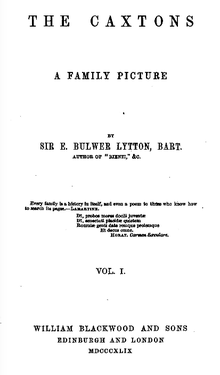The Caxtons
 First edition title page to Vol. I. | |
| Language | English |
|---|---|
| Publisher | William Blackwood and Sons (Edinburgh) |
Publication date | 1849 |
The Caxtons: A Family Picture is an 1849
The book was first serialized anonymously in
The novel was "instantly popular" in Britain and also sold 35,000 copies within three years of its release in the United States.[3]
Plot
A synopsis of the plot from a 1910 reference work states:
The Caxtons are Austin Caxton, a scholar engaged on a great work, "The History of Human Error;" his wife Kitty, much his junior; his brother Roland, the Captain, who has served in the
Cambridge University, where his college course is soon closed by the financial troubles of his father. A further outline of this story would give no idea of its charm. The mutual affection of the Caxtons is finely indicated, and the gradations of light and shade make a beautiful picture. Never before had Bulwer written with so light a touch and so gentle a humor, and this novel has been called the most brilliant and attractive of productions. His gentle satire of certain phrases of political life was founded, doubtless, on actual experience.[3]
The Caxtons are asserted to have descended from William Caxton, the first English printer. In the latter part of the novel, two characters emigrate to Australia, and emigration is positively depicted as a chance for redemption.[4]
Pisistratus Caxton also serves as the nominal narrator of My Novel (1853) and What Will He Do With It? (1858).[1]
Legacy
From the time of its release, comparisons of the work to Tristram Shandy were frequent, with a few commentators suggesting the borrowing was perhaps too much, but the former work can be ultimately seen more generally as an inspiration than a source text.[5][6][7][8]
The Stanford Companion to Victorian Fiction (1989) states that the "domestic milieu and easy-going narrative manner" of The Caxtons stands in contrast to the author's prior melodramatic works, and "marks a turning point in Bulwer-Lytton's career, and in Victorian fiction generally."[1]
The description of Edgar Allan Poe in Rufus Wilmot Griswold's negative and much-republished 1849 obituary of Poe is in part a lengthy quote of the description of the character Frances Vivian in The Caxtons. The passage was marked with quotes in the original obituary, but the quotes were omitted when later republished.[9]
References
- ^ a b c d Sutherland, John. The Stanford Companion to Victorian Fiction, p. 111 (1989)
- ^ Mathews, William. Introduction to 1896 reprint, at p. x
- ^ a b Warner, Charles Dudley, ed. Warner's synopsis of books ancient and modern, Vol. II, p. 134 (1910 edition)
- ^ Knox, Bruce, The Earl of Carnarvon: Highclere, Hampshire, and Empire, in Taylor, Miles (ed.) Southampton: Gateway to the British Empire, at p. 20 (2007)
- ^ Tuckerman, Bayard Lord Lytton, in The Princeton Review, at p. 270 (November 1884)
- ^ Tristram Shandy or The Caxtons?, Fraser's Magazine (March 1856), pp. 253-67
- ^ Dictionary of National Biography, Vol. LIV, p. 218 (1898) (stating that the book "levied ampler loans on Sterne's pictures of Mr. Shandy and his household than a stern sense of probity might justify")
- ^ Sir Edward Bulwer Lytton's Later Novels, in The Quarterly Review, Vol. 117, at pp. 370-71 (London, April 1865)("It is not enough to admit that advantage has been taken of eminent model ...")
- ^ Peeples, Scott. The Afterlife of Edgar Allan Poe, p. 5 (2004)
External links
- The Caxtons: A Family Picture at Project Gutenberg
- The Caxtons (1855 print at Google books)
 The Caxtons: A Family Picture public domain audiobook at LibriVox
The Caxtons: A Family Picture public domain audiobook at LibriVox

